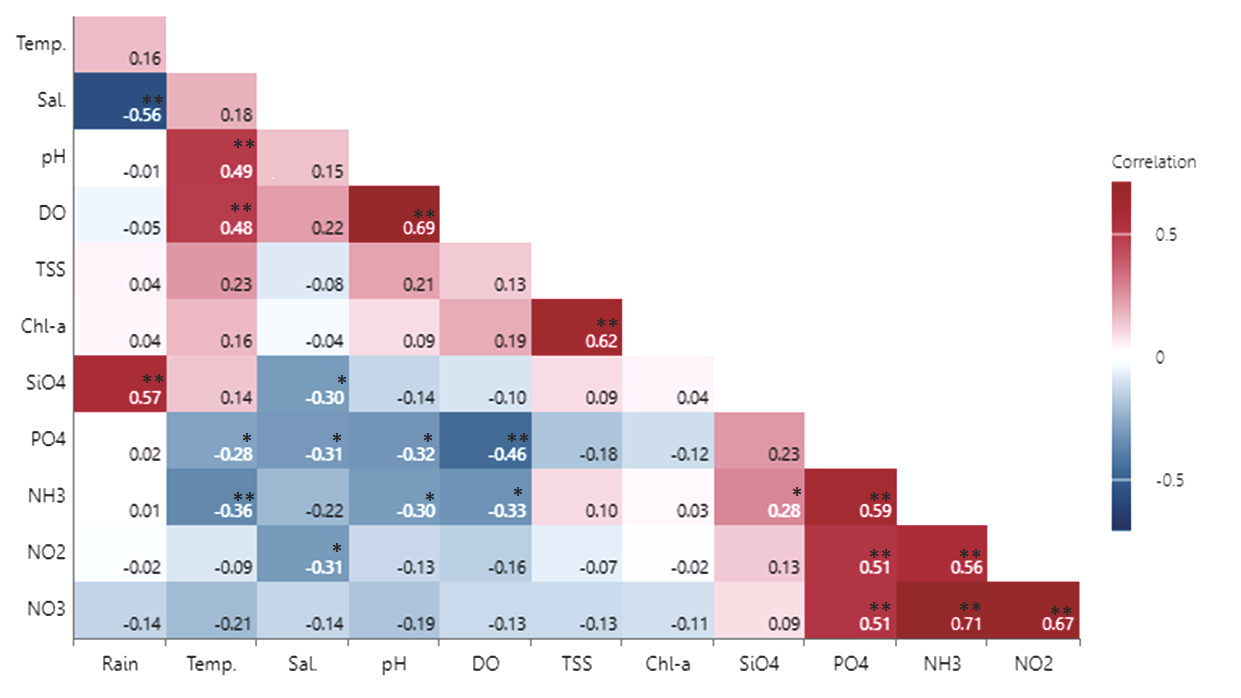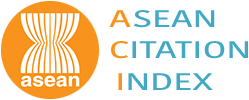Impacts of Water Quality Changes on Eutrophication and Phytoplankton in the Coastal Areas of Chonburi Province in 2022
Keywords:
water quality , eutrophication, phytoplankton, ChonburiAbstract
Background and Objectives : The coastal area of Chonburi Province serves as a critical economic hub of Thailand, primarily driven by its tourism, industry, and fisheries sectors. This region boasts abundant natural resources and iconic attractions, including beaches, coral reefs and mangrove forests, which contribute significantly to the nation's economic development. However, rapid urbanization, industrial expansion, and increasing tourism activities have exerted pressure on the coastal environment, leading to declining water quality. Key contributors to this issue include wastewater discharge from communities and tourism establishments, along with nutrient enrichment from water circulation in the Gulf of Thailand. These factors promote eutrophication, often resulting in frequent and large-scale phytoplankton blooms. The proliferation of phytoplankton can severely deplete dissolved oxygen levels, causing hypoxic conditions that threaten marine organisms and ecosystems, ultimately reducing biodiversity and impairing ecosystem functions. Recognizing the critical need to address these challenges, this study aims to explore the intricate relationships between water quality parameters, eutrophication, and phytoplankton community composition in the coastal waters of Chonburi Province. The research will focus on identifying key factors associated with eutrophication and phytoplankton bloom formation. Additionally, it seeks to develop robust monitoring systems and early-warning mechanisms to minimize adverse impacts, ensuring sustainable management and effective mitigation of future environmental challenges in the region.
Methodology : Water quality and phytoplankton samples were collected from four coastal monitoring stations in Chonburi Province: Laem Tan, Wannapha Beach, Bang Phra, and Koh Loi, between June and December 2022, to investigate the relationship between water quality and phytoplankton dynamics. General water quality parameters, such as temperature, salinity, dissolved oxygen, and pH, were measured using a YSI Model 2030 and a pH meter. Surface water samples were collected at a depth of 30 cm to analyze total suspended solids (TSS), chlorophyll a, ammonia, nitrite, nitrate, phosphate, silicate, total dissolved nitrogen (TDN), and total dissolved phosphorus (TDP) in the laboratory. Phytoplankton samples were obtained by filtering 40 liters of water from a depth of 50 cm through a 20-micron plankton net. These samples were then examined under a microscope to classify and count phytoplankton present, allowing for an assessment of their diversity and density. A comparative analysis of water quality and phytoplankton differences across locations and time periods was conducted using One-way ANOVA. Additionally, Pearson’s correlation coefficient and Multiple Linear Regression analysis were performed using Minitab Statistical Software to identify the factors influencing changes in water quality and the composition of phytoplankton in the study area.
Main Results : The results of the general water quality study revealed average values for key parameters, including temperature (30.0±1.3°C), salinity (24.4±5.4 psu), pH (8.1±0.3), dissolved oxygen (4.6±1.5 mg/l), suspended solids (65.3±88.8 mg/l), and chlorophyll a (15.4±29.4 µg/l). Most values were within the standard criteria for coastal water quality suitable for aquaculture, except for chlorophyll a, which exceeded the standard. The elevated chlorophyll a level indicated significant eutrophication, ranging from Eutrophic to Hypertrophic throughout the study period. This was particularly evident in August at the Wannapha Beach station, where a phytoplankton bloom of Bellerochea spp. was observed. The study of dissolved nutrients showed average concentrations of ammonia (186.8±169.0 µg/l), nitrite (17.5±21.5 µg/l), nitrate (67.1±115.8 µg/l), phosphate (29.8±22.2 µg/l), silicate (413.1±195.3 µg/l), total dissolved nitrogen (44.7±24.9 µg/l), and total dissolved phosphorus (44.7±24.9 µg/l). Ammonia concentrations often exceeded standard levels, especially in October. Phytoplankton diversity analysis identified 55 genera from four major classes: Cyanophyceae, Chlorophyceae, Bacillariophyceae, and Dinophyceae. Dominant genera included Chaetoceros spp., Coscinodiscus spp., and Thalassiosira spp., consistently present at all stations. The analysis of the relationships between various factors revealed that rainfall has a negative correlation with water salinity, as rainfall can reduce salinity in coastal areas. Meanwhile, chlorophyll-a is positively correlated with suspended solids and ammonia. Additionally, it was found that the density of Cyanophyceae phytoplankton increases when ammonia levels in the water are high, indicating the occurrence of eutrophication and phytoplankton blooms in the area.
Conclusions : The study on the correlation of water quality on eutrophication and phytoplankton in the coastal areas of Chonburi revealed that water quality parameters did not vary significantly across the stations, likely due to the smooth flow and mixing of coastal currents. However, seasonal changes were observed, especially in October, when heavy rainfall contributed to an influx of nutrients, causing ammonia concentrations to exceed the standard levels. This nutrient enrichment led to higher chlorophyll concentrations and increased phytoplankton density. Analysis of chlorophyll a and nutrient levels indicated that the coastal waters of Chonburi were consistently classified as eutrophic to hypertrophic throughout the study period. Phytoplankton from the Bacillariophyceae class, such as Chaetoceros spp., Coscinodiscus spp. and Thalassiosira spp. dominated the phytoplankton community in the area. The study also identified ammonia as a critical factor driving eutrophication and phytoplankton blooms. To mitigate these impacts, regulation and continuous monitoring of ammonia concentrations exceeding the standard are essential. These measures aim to prevent potential ecological disturbances, maintain biodiversity, and safeguard the sustainability of fisheries and aquatic resources in the coastal waters of Chonburi Province.
References
American Public Health Association - APHA (1992). Standard Methods for the Examination of Water and Wastewater including Sediments and Sludges (18th ed.). American Public Health Association, American Water Works Association and the Water Environment Federation, Washington DC., USA.
Bi, R., Li, M., Liu, H., Li, H., Su, W., & Xu, J. (2021). Responses of marine diatom-dinoflagellate competition to multiple environmental drivers: Abundance, elemental, and biochemical aspects. Frontiers in Microbiology, 12, 731786.
Buranapratheprat, A. (2008). Circulation in the Upper Gulf of Thailand: A review. Burapha Science Journal, 13(1), 75-83. (in Thai)
Buranapratheprat, A., Kan-atireklarp, S., Yuenyong, S., & Kan-atireklap, S. (2018). Fluxes of suspended sediment and dissolved inorganic nutrients at the Welu River mouth in dry and wet seasons in 2014. Burapha Science Journal, 23(1), 546-556. (in Thai)
Chaianarong, K., & Pimprapai, S. N. A. (2018). Eastern Seaboard Industrial Development Program suggestions from people’s perspectives: A synthesis for a transition to Eastern Economic Corridor development that creates social justice. Burapha Journal of Political Economy, 6(1), 40–62. (in thai)
Conkright, M. E., Gregg, W. W., & Levitus, S. (2000). Seasonal cycle of phosphate in the open ocean.Deep-Sea Research I: Oceanographic Research Papers, 47(1), 159-175.
Deesuk, A., & Punnarak, P. (2017). Seasonal variation of phytoplankton communities at Sichang Island, Chonburi Province. Proceedings of the National and International Graduate Research Conference 2017, Khon Kaen University, 530-541. (in thai)
Department of Fisheries-DOF. (2021). Statistics of marine shellfish culture survey 2020. Department of Fisheries, Fisheries Statistics Group, Bangkok. (in Thai)
Department of Marine and Coastal Resources - DMCR. (2021). State of marine and coastal resources and coastal erosion: Thailand national report 2021. Ministry of Natural Resources and Environment, Bangkok. (in Thai)
Domingues, R. B., Anselmo, T. P., Barbosa, A. B., Sommer, U., & Galvão, H. M. (2011). Nutrient limitation of phytoplankton growth in the freshwater tidal zone of a turbid, Mediterranean estuary. Estuarine, Coastal and Shelf Science, 91(2), 282–297.
Ernst, A., Deicher, M., Herman, P. M. J., & Wollenzien, U. I. A. (2005). Nitrate and phosphate affect cultivability of cyanobacteria from environments with low nutrient levels. Applied and Environmental Microbiology, 71(6), 3379–3383.
Gassen, L., Esters, L., Ribas-Ribas, M., & Wur, O. (2024). The impact of rainfall on the sea surface salinity: A mesocosm study. Scientific Reports, 14, 6353.
Grasshoff, K., Kremling, K., & Ehrhardt, M. (1999). Methods of seawater analysis (3rd ed.). Wiley-VCH.
Heramza, K., Barour, C., Djabourabi, A., Khati, W., & Bouallag, C. (2021). Environmental parameters and diversity of diatoms in the Aïn Dalia dam, Northeast of Algeria. Biodiversitas, 22(9), 3633-3644.
Howarth, R. W., & Marino, R. (2006). Nitrogen as the limiting nutrient for eutrophication in coastal marine ecosystems: Evolving views over three decades. Limnology and Oceanography, 51(1), 364–376.
Maslukah, L., Setiawan, R. Y., Nurdin, N., Helmi, M., & Widiaratih, R. (2022). Phytoplankton chlorophyll-a biomass and the relationship with water quality in Barrang Caddi, Spermonde, Indonesia. Ecological Engineering & Environmental Technology, 23(1), 25–33.
Meteorological Department of Thailand – TMD. (2022). Average monthly rainfall in Chonburi Province. Bangkok. (in Thai)
Na-u-dom, T., Buranapratheprat, A., Homhual, K., & Intracharoen, P. (2013). Temporal and spatial variations of water qualities in the upper Gulf of Thailand during two seasons in 2009. Burapha Science Journal, 18(2), 32–42. (in Thai)
Ons Daly Yahia-Kefi, Souissi, S., De Stefano, M., & Daly Yahia, M. N. (2005). Bellerochea horologicalis and Lithodesmioides polymorpha var. tunisiense var. nov. (Coscinodiscophyceae, Bacillariophyta) in the Bay of Tunis: Ultrastructural observations and spatio-temporal distribution. Botanica Marina, 48(1), 58–72.
Pransilpa, M., Asiranan, I., & Chuenniyom, W. (2010). Species diversity and abundance of phytoplankton in the estuaries of Trat, Chantaburi, and Rayong River. Proceedings of the 4th Marine Science Conference, Prince of Songkla University, Thailand. (in Thai)
Pollution Control Department-PCD. (2006). Surface Water Quality Standards & Criteria in Thailand. Ministry of Science, Technology and Environment. (in Thai)
Smith, V. H. (2003). Eutrophication of freshwater and coastal marine ecosystems: A global problem.Environmental Science & Pollution Research, 10(2), 126-139.
Smith V.H., Tilma G.D. & Nekola J.C. (1999). Eutrophication: impacts of excess nutrient inputs on freshwater, marine, and terrestrial ecosystems. Environmental Pollution, 100 (1999),179-196.
Sobolev, D., Moore, K., & Morris, A. L. (2009). Nutrients and light limitation of phytoplankton biomass in a turbid southeastern reservoir: Implications for water quality. Southeastern Naturalist, 8(2), 255–266.
Srisunont, C., Srisunont, T., Intarachart, A., & Babel, S. (2022). Influence of climate on seawater quality and green mussel production. SCI. MAR. ,86(1).
Strickland, J.D.H., & Parsons, T.R. (1972). A Practical Handbook of Seawater Analysis. Fishery Research Board of Canada, Ottawa.
Talab, S., Munhapon, A., & Wongsudawan, W. (2010). Monitoring of phytoplankton density in marine bivalve aquaculture farms of Chon Buri Bay, Chon Buri Province. Proceedings of the 4th Marine Science Conference, Prince of Songkla University, Thailand. (in Thai)
Thaipichitburapa, P. ,& Meksumpun, C. (2021). The effects of dissolved inorganic nutrients on eutrophication situations of Trat Bay, Trat Province. Burapha Science Journal, 26(2), 771–784. (in Thai)
Thongchab, P., & Chayakulal, T. (2023). The relationship between air and water temperature in rice paddy fields. Proceedings of the 52nd Kasetsart University Annual Conference: Plant Science, 28, SGI03–1. (in Thai)
Vonnahme, T. R., Leroy, M., Thoms, S., van Oevelen, D., Harvey, H. R., Kristiansen, S., Gradinger, R.,Dietrich, U., & Volker, C. (2002). Modeling silicate–nitrate–ammonium co-limitation of algal growth and the importance of bacterial remineralization based on an experimental Arctic coastal spring bloom culture study. Marine Ecology Progress Series, 239(1), 233–239
Wongrat, L. (1999). Phytoplankton, Department of Fishery Biology, Faculty of Fisheries, Kasetsart University, Bangkok, Thailand. (in Thai)
Wongrat, L & Boonyapiwat, S. (2003). Manual of Sampling and Analytical Methods of Plankton,Kasetsart University, Bangkok, Thailand. (in Thai)
Yuan, M., Jiang, C., Weng, X., & Zhang, M. (2020). Influence of salinity gradient changes on phytoplankton growth caused by sluice construction in Yongjiang River estuary area. Water, 12, 2492.

Downloads
Published
How to Cite
Issue
Section
License
Copyright (c) 2025 Faculty of Science, Burapha University

This work is licensed under a Creative Commons Attribution-NonCommercial-NoDerivatives 4.0 International License.
Burapha Science Journal is licensed under a Creative Commons Attribution-NonCommercial-NoDerivatives 4.0 International (CC BY-NC-ND 4.0) licence, unless otherwise stated. Please read our Policies page for more information



